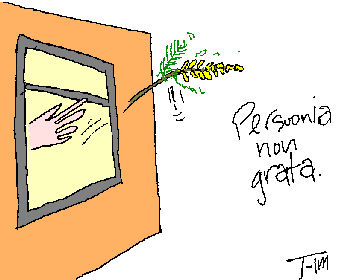|
[Front Page] [Features] [Departments] [SGAP Home Page] [Subscribe]

First Cuttings..an Editorial Rant!

Perhaps the most frustrating group of Australian plants as far as propagation is concerned is the "Geebung" group (Persoonia species). No other genus produces such seemingly perfect cutting material which sits "unrooted" for months in the propagation house until it finally deteriorates (and becomes "completely rooted!") It doesn't seem to matter whether root-promoting hormones are used or whether the cuttings are kept under mist. Even prayers remain unanswered! Experienced propagators usually save themselves a lot of stress by immediately throwing out propagation material received from well-meaning (but naive) acquaintances, thus shortening the process by several months. It might be an unusual propagation method, they argue, but it's just as successful as the more traditional procedures!
To add insult to extensive injury, seed propagation is even less successful than propagation from cuttings. Sad but true....
Actually, propagation of persoonias is not impossible, although it comes close. The annoying thing is that a successful experience can rarely be repeated even if scrupulous records are kept. A few species are a bit easier than others. A recent report in one of the Society's newsletters suggested that P.linearis is reasonably co-operative. But I'm not convinced...it's one that I've tried unsuccessfully. Perhaps some clones strike easier than others.
Anyway, if you've had any luck with Persoonia, why not share your secrets?

Botanic Gardens in Trouble
I recently received a fairly disturbing email which I'd like to share with you. When an organisation decides to seek help using the message "Please HELP!! - Botanical Gardens in distress!", it's an indication of serious trouble. The following message was received from Les Gordon of the Royal Tasmanian Botanical Gardens, Australia. If any reader can help directly, please do so or if you can suggest internet sites which might be willing to establish the requested link, please contact the Gardens directly:
"I'm writing to you today with the hope of enlisting your aid in a campaign to save the Royal Tasmanian Botanical Gardens of Australia. The wonderful trees and shrubs of the Botanical Gardens, some dating back to 1828, are under attack by the Armillaria luteobubafina fungus, which is a variety of
root-rot fungus endemic to Australia. Since the problem was discovered in 1994, 33 trees have already been lost and unless a solution can be found, the whole area is under threat.
|
| "Since the problem was discovered in 1994, 33 trees have already been lost and unless a solution can be found, the whole area is under threat." |
|
In association with the Mercury newspaper, the Gardens have undertaken a funding and public awareness campaign in an effort to help combat this problem. As part of this campaign, a web-site has been established to
explain the situation to the on-line public and help rally support for this very important cause. As well as funding, input is being sought from the world-wide scientific community. What I ask is, that you might include a
link to this site in a prominent place on the web-site which you administer or are associated with:
http://www.clandh.com.au/rtbg/index.htm
The email address for the Gardens is: rtbg@ice.net.au.
If you know of any other sites which would be willing to do the same, please pass this request on to them also. This action could well help to save the lives of many trees which were planted by generations past and,
given the chance, will be there for many future generations to admire and enjoy."
Needless to say, the link has been included in the Society's "Internet Resources" page.

On the Edge
If you're in the Blue Mountains (west of Sydney), a visit to "The Edge" giant-screen cinema is definitely worth considering. A film of the same name, which screens a regular intervals, is a wonderful introduction to the Blue Mountains for those who haven't been there before and will even make regular visitors sit up and take notice.
The huge screen and imaginative camera work produce the feeling of being part of the film. You feel your stomach drop as the camera follows water over the edge of a cliff and you sway from side to side as a helicopter sweeps through the gorges. It's exhilarating stuff! But it's not just done for effect; you see parts of the Mountains that only dedicated bushwalkers and abseilers would normally be able to see. You also hear the story of the discovery of the now famous Wollemi Pine (Wollemia nobilis) and visit the site with a blindfolded camera crew (so they can't divulge the location of the plants - presumably the helicopter pilot wasn't blindfolded, though!). The pictures of these magnificent trees are stunning. You also visit Microstrobus fitzgeraldii, a small conifer that survives in the spray of a couple of waterfalls and which is threatened by polluted urban runoff.
The film is aimed at a general audience but, I'd be surprised if those with a bit more ecological knowledge than average didn't get something out of it. You'll find "The Edge" on the Great Western Highway at Katoomba, just east of the township.
Until next time...good growing.
Brian Walters
 [Front Page] [Features] [Departments] [SGAP Home Page] [Subscribe]
[Front Page] [Features] [Departments] [SGAP Home Page] [Subscribe]
Australian Plants online - December 1996
The Society for Growing Australian Plants
|